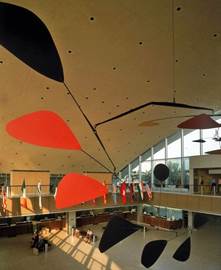Home >Blog > Post
By Larry Romero
American artist Alexander Calder redefined the art of sculpture by introducing the element of harmonious movement into his work with abstract mobiles. In the 1950s, when the International Arrivals Building was originally being constructed at what is now John F. Kennedy International Airport, Calder was commissioned to install a very large mobile in the center of the main lobby.
Decades later, Jack Gartner, who was the airport’s building manager at the time, recalled his experience of caring for the installation:1
 It was about 10–12 large pieces, if I remember, of varying colors, hung from a ceiling above the second floor, a good 50–60 feet above the floor, so you can imagine the pieces were pretty large. A spectacular piece! Every year, the mobile was taken down by our Maintenance Department and replaced with holiday decorations for Christmas and New Year’s Eve.
It was about 10–12 large pieces, if I remember, of varying colors, hung from a ceiling above the second floor, a good 50–60 feet above the floor, so you can imagine the pieces were pretty large. A spectacular piece! Every year, the mobile was taken down by our Maintenance Department and replaced with holiday decorations for Christmas and New Year’s Eve.
One year, sometime in the late ’70s, I’d say, Maintenance replaced the Calder after the holidays. It didn’t hang correctly … something was out of whack. Investigation was made, heads scratched, until voila! It turns out that Maintenance had decided to repaint the installation, and used different paint than had been used previously, and the slight difference in the weight of that paint along with the amazing sensitivity of the unit made it hang incorrectly. They found the correct paint, redid the job, and it was fixed.
Gartner’s story calls attention to the delicate equilibrium and compositional harmony Calder built into his mobiles. A similar creative process applies in building and maintaining a strong workplace culture. Just as Calder carefully balanced the pieces of his mobiles, leaders balance values, beliefs, and actions in their efforts to realize harmonious equilibrium within their organization.
When a clear set of values and norms guides the workplace, great things start to happen. Rather than just trying to make it through another day avoiding conflict with colleagues, navigating unclear team objectives, or questioning the organization’s direction due to seemingly arbitrary leadership decisions, employees begin to feel engaged. They work from a place of clarity and stability underpinned by trust, pride, confidence, and empowerment. This manifests in increased employee interaction, more meaningful and effective internal communications, and a healthy level of risk taking that, through successes and failures, produce value-rich market solutions.
Based on its 30 years of research surveying millions of employees from thousands of companies worldwide, the firm Great Place to Work® defines a great workplace as one where employees trust the people they work for, have pride in the work they do, and enjoy the people they work with.2 These values likely came into play when Jack Gartner and his colleagues were working to solve the mystery of the “out of whack” Calder mobile. And, in his enthusiastic telling of his story, Gartner’s clear sense of engagement shines through, likely benefiting not only the airport’s staff but also its customers and bottom line.
It turns out this is a rare occurrence. Bersin by Deloitte reveals that a meager 13% of the employees they interviewed across 142 countries reported being emotionally invested in their job. Worse, actively disengaged employees—those who are negative and potentially hostile toward their employers—outnumbered engaged employees two to one. According to Gallup, low engagement results in $800 billion annually in lost productivity and hiring costs worldwide.3
It’s no wonder that global leaders rank workplace culture as a top business priority. In a 2014 Korn Ferry survey of global executives, 72% agreed that culture is extremely important to organizational performance, yet only 32% said their culture aligned with their business strategy.4 Referencing Korn Ferry’s 2015 study on culture, senior partner Jacqueline Gillespie notes, “In previous years, culture was not viewed as a priority. That has changed. There’s now a widespread recognition that culture has a significant impact in supporting a business strategy.5
Without question, getting culture right is critically important. But it’s not easy. Like a Calder mobile, organizational culture will shift and change in response to forces internal and external, seen and unseen, whether or not anyone is paying it any attention. Building a culture that has the strength and flexibility to withstand such forces requires purposeful dedication.
Here’s where you come in.
Now that culture is appropriately being viewed as a journey rather than an end point, organizational leaders are recognizing their need for expert guidance in bridging the divide between organizational performance and business strategy. As an MBTI® practitioner, with your expertise in applying the MBTI® framework, you are ideally positioned to provide it.
Are you ready? Let us help. Just as Jack Gartner had a team to rely on for approaching challenges from multiple angles, so do you with CPP.
Designed just for you, this year’s MBTI Users Conference focuses on helping you open your clients’ eyes to a new way of thinking about workplace culture. This intimate learning event will immerse you in a dynamic exchange of knowledge, practices, and ideas intended to help you gain new insights. It will serve as an in-person forum for learning and enhancing individual, team, and organizational development methods and for discovering different ways to increase effectiveness—all of which are essential ingredients for building a stronger workplace culture.
Indeed, culture matters. Plus the ROI can be huge. CEB (formerly Corporate Executive Board) states that for every 5,000 employees, improving the quality of culture can save up to $67 million in employee productivity.6 The time couldn’t be better for you to leverage the investment you’ve made in yourself and to help leaders tackle this top business issue.